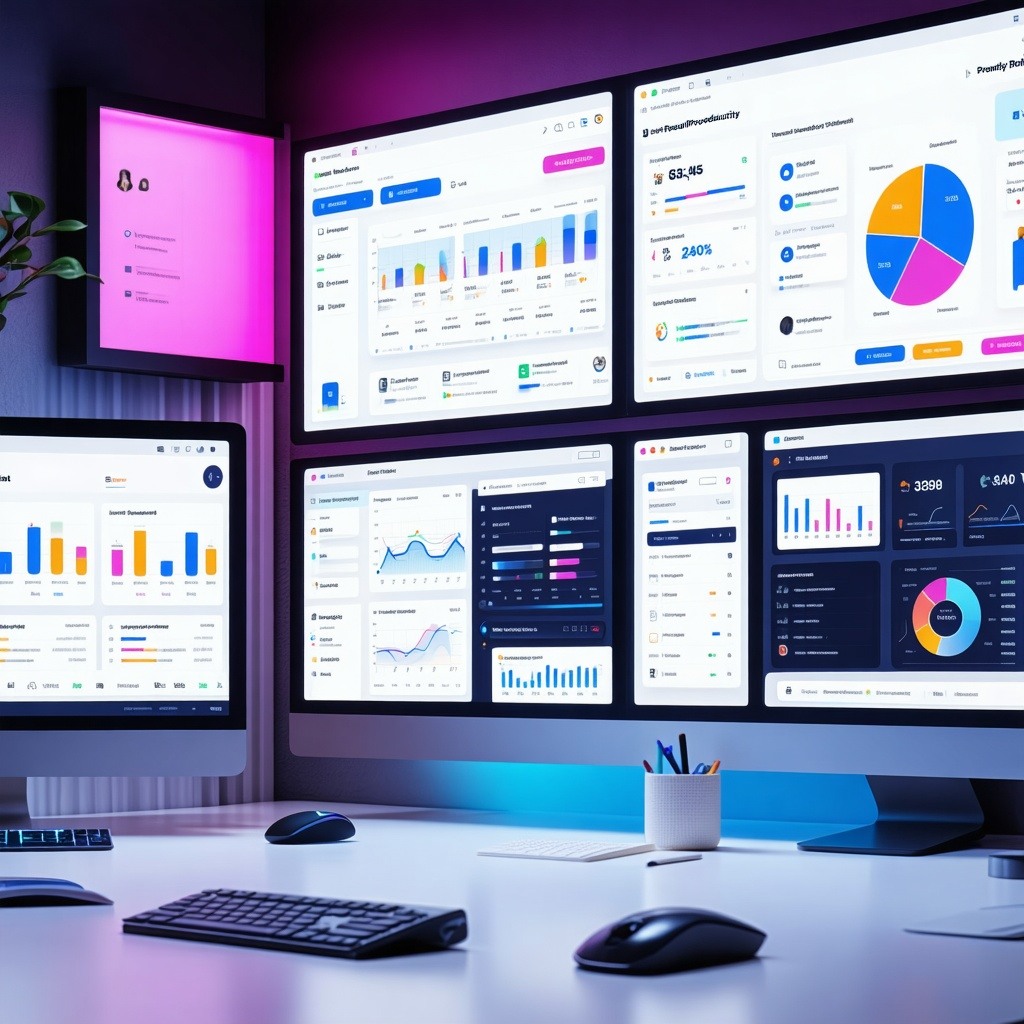10 Effective Work-Life Balance Techniques for Busy Professionals
Many professionals struggle with managing their time effectively. Juggling multiple tasks, meeting deadlines, and trying to maintain personal relationships can lead to stress and burnout. If you've ever felt overwhelmed by your workload or found it difficult to carve out time for yourself, you're not alone.
Achieving a harmonious work-life balance is essential for both productivity and personal well-being. This post will dive into ten practical techniques that can help you navigate the complexities of a busy schedule. From prioritizing tasks to leveraging technology, these strategies are designed to provide you with actionable solutions to enhance your daily routine.
By implementing these work-life balance techniques, you can not only boost your productivity but also create a more fulfilling and sustainable lifestyle. Let's explore how you can take control of your time and achieve a balanced approach to work and life.
Prioritize Your Tasks
Effective prioritization is the cornerstone of managing a busy schedule. Start by identifying your most important tasks each day and tackle them first. This ensures that you focus on what truly matters and make the most of your productive hours.
Implementing a priority matrix, such as the Eisenhower Box, can help you categorize tasks based on urgency and importance. By doing so, you can better allocate your time and resources, ensuring that critical tasks are completed promptly.
For instance, Sarah, a project manager, noticed her productivity dropping due to an overwhelming to-do list. By prioritizing her tasks using the Eisenhower Box, she was able to focus on high-impact activities, resulting in increased efficiency and reduced stress.
According to a study by the Harvard Business Review, prioritizing tasks can lead to a significant boost in productivity, as it helps individuals focus on what truly matters and avoid getting bogged down by less important activities.
Set Clear Boundaries
Establishing clear boundaries between work and personal life is crucial for maintaining balance. Define specific work hours and stick to them, ensuring that your personal time remains uninterrupted.
One effective strategy is to create a dedicated workspace, even if you're working from home. This physical separation helps signal to your brain when it's time to focus and when it's time to relax. Additionally, communicate your boundaries to colleagues and family members to minimize distractions during your work hours.
John, a software developer, struggled to disconnect from work after hours. By setting a strict end time to his workday and designating a separate office space, he was able to enjoy his evenings without work-related stress.
As Sheryl Sandberg, COO of Facebook, emphasizes, "You cannot overestimate the importance of boundaries to your work-life balance."
Utilize Time Management Tools
Leverage time management tools to organize your schedule and streamline your tasks. Tools like digital calendars, task managers, and project management software can help you stay on track and ensure that nothing falls through the cracks.
For example, using a tool like Trello allows you to visualize your projects and prioritize tasks effectively. By organizing your work visually, you can better manage deadlines and collaborate with team members seamlessly.
Emily, a marketing executive, integrated Trello into her workflow and saw a drastic improvement in her ability to manage multiple campaigns simultaneously. This not only increased her productivity but also reduced the likelihood of missing important deadlines.
Research from the American Psychological Association shows that effective use of time management tools can significantly reduce work-related stress and enhance overall performance.
Practice Mindfulness and Stress Management
Incorporating mindfulness practices into your daily routine can help manage stress and improve focus. Techniques such as meditation, deep breathing, and yoga can enhance your mental clarity and resilience.
Take short breaks throughout the day to practice mindfulness. This can recharge your energy levels and reduce the negative effects of prolonged stress. Allocating time for relaxation ensures that you remain productive without compromising your well-being.
Michael, a financial analyst, began practicing meditation during his lunch breaks. He found that this practice not only reduced his stress levels but also improved his concentration and decision-making skills throughout the day.
A study published in the Journal of Occupational Health Psychology found that regular mindfulness practice can lead to significant improvements in work performance and job satisfaction.
Delegate and Outsource
Recognize that you don't have to do everything yourself. Delegating tasks to capable team members or outsourcing certain responsibilities can free up your time and allow you to focus on higher-level priorities.
Start by identifying tasks that others can handle and assign them accordingly. Ensure that you provide clear instructions and the necessary resources to accomplish these tasks effectively.
For instance, Anna, a small business owner, outsourced her accounting duties to a professional service. This allowed her to concentrate on strategic planning and business development, ultimately contributing to her company's growth.
According to a report by the International Journal of Human Resource Management, effective delegation can enhance team performance and increase individual productivity by reducing workload and allowing for focus on key responsibilities.
Set Realistic Goals
Setting achievable goals is key to maintaining motivation and avoiding burnout. Break down larger objectives into smaller, manageable tasks that can be accomplished within a specific timeframe.
Using the SMART criteria (Specific, Measurable, Achievable, Relevant, Time-bound) can help you set clear and attainable goals. This structured approach ensures that your goals are realistic and aligned with your overall priorities.
Mark, a sales executive, began setting SMART goals for his monthly targets. By breaking down his objectives into smaller tasks, he was able to track his progress more effectively and maintain a steady performance throughout the year.
Research from the American Management Association indicates that individuals who set realistic goals are more likely to achieve higher levels of productivity and job satisfaction.
Embrace Flexible Work Arrangements
Flexible work arrangements, such as remote work or flexible hours, can significantly enhance your work-life balance. These arrangements allow you to tailor your work schedule to better fit your personal needs and responsibilities.
Communicate with your employer about the possibility of flexible work options. This can lead to a more adaptable and supportive work environment, enabling you to manage both professional and personal commitments effectively.
Jessica, a graphic designer, transitioned to a remote work setup which allowed her to better manage her family responsibilities while maintaining her productivity. This flexibility not only improved her work-life balance but also increased her job satisfaction.
A Gallup study found that employees with flexible work arrangements report higher levels of well-being and engagement compared to those with rigid schedules.
Limit Distractions and Improve Focus
Minimizing distractions is essential for maintaining focus and productivity. Identify common distractions in your work environment and take steps to eliminate or reduce them.
One method is to implement the Pomodoro Technique, which involves working in focused intervals followed by short breaks. This technique helps maintain concentration and prevents burnout by providing structured periods of rest.
Kevin, a content writer, struggled with frequent interruptions at his home office. By using noise-canceling headphones and setting specific work intervals, he was able to enhance his focus and produce higher-quality content.
According to a study by the University of California, distractions can significantly impair cognitive performance and lead to decreased productivity.
Maintain a Healthy Lifestyle
A healthy lifestyle plays a crucial role in sustaining productivity and achieving work-life balance. Prioritize regular exercise, a balanced diet, and adequate sleep to ensure that your body and mind function optimally.
Incorporate physical activity into your daily routine, whether it's a morning jog, a yoga session, or a simple walk during lunch breaks. Maintaining a healthy lifestyle not only boosts your energy levels but also enhances your mental clarity and resilience.
Laura, a legal consultant, integrated daily exercise into her schedule. This not only improved her physical health but also increased her overall productivity and ability to handle work-related stress.
Research from the World Health Organization highlights that maintaining a healthy lifestyle can reduce the risk of chronic illnesses and improve mental health, contributing to better work performance.
Foster Strong Relationships
Building and maintaining strong relationships, both professionally and personally, is essential for work-life balance. Supportive relationships provide emotional support, reduce stress, and contribute to overall well-being.
Take time to connect with colleagues, friends, and family members regularly. Engaging in meaningful conversations and collaborative activities can strengthen these relationships and create a support network that helps you navigate challenges.
For example, Tom, a team leader, organized regular team-building activities that not only improved workplace camaraderie but also enhanced collaboration and productivity within his team.
A study published in the Journal of Applied Psychology found that strong interpersonal relationships at work are linked to higher job satisfaction and reduced stress levels.
Continuous Learning and Skill Development
Investing in continuous learning and skill development can enhance your efficiency and adaptability in both professional and personal settings. By expanding your skill set, you can manage tasks more effectively and seize new opportunities.
Enroll in courses, attend workshops, or engage in self-directed learning to stay updated with industry trends and improve your competencies. This proactive approach not only boosts your confidence but also contributes to career growth and personal satisfaction.
For instance, Maria, a marketing specialist, pursued a certification in digital marketing. This not only increased her expertise but also opened up new avenues for career advancement within her organization.
According to the Society for Human Resource Management, continuous learning is a key factor in employee engagement and retention, as it fosters a sense of progress and accomplishment.
Take Time Off and Recharge
Regularly taking time off to rest and recharge is vital for maintaining long-term productivity and preventing burnout. Allocate time for vacations, short breaks, and personal activities that help you relax and rejuvenate.
Ensure that you disconnect from work during your time off by setting boundaries and avoiding work-related tasks. This break allows you to return to work with renewed energy and a fresh perspective, enhancing your overall performance.
David, a consultant, made it a priority to take short breaks throughout his workday and scheduled annual vacations. This practice not only improved his mental health but also increased his productivity and job satisfaction.
A report from the National Institute for Occupational Safety and Health (NIOSH) emphasizes the importance of regular breaks and vacations in reducing workplace stress and enhancing employee well-being.
Optimize Your Workspace
Creating an organized and comfortable workspace can significantly impact your productivity and work-life balance. An optimized workspace reduces distractions and creates an environment conducive to focused work.
Ensure that your workspace is clean, well-lit, and ergonomically designed to prevent physical strain and enhance comfort. Personalize your space with items that inspire and motivate you, fostering a positive mindset.
For example, Lisa, a freelance writer, redesigned her home office with better lighting and ergonomic furniture. This improvement not only enhanced her comfort but also increased her productivity by reducing physical discomfort and distractions.
Research by the American Society of Interior Designers indicates that a well-organized workspace can improve efficiency, reduce stress, and promote a healthier work-life balance.
Embrace Technology Wisely
Leveraging technology can streamline your tasks and enhance your work-life balance. Utilize productivity apps, automation tools, and smart devices to simplify your workflow and save time.
However, it's essential to use technology judiciously to avoid potential distractions. Set boundaries for technology use, such as designated times for checking emails or social media, to maintain focus and prevent burnout.
Jake, an entrepreneur, adopted automation tools for his email marketing campaigns, saving him several hours each week. This allowed him to focus on strategic planning and business development, contributing to his company's growth.
A report by McKinsey Global Institute highlights that effective use of technology can significantly boost productivity by automating repetitive tasks and enhancing collaboration.
Conclusion
Achieving a work-life balance is a continual process that requires intentional strategies and disciplined execution. By prioritizing tasks, setting clear boundaries, and leveraging the right tools, you can enhance your productivity while maintaining personal well-being. Incorporating mindfulness practices, delegating responsibilities, and fostering strong relationships further support a balanced lifestyle. Remember, taking time to recharge and continuously developing your skills are essential components of sustained success.
Implementing these techniques can transform your daily routine, enabling you to manage your professional obligations without sacrificing your personal life. To assist you in this journey, consider utilizing a productivity app to seamlessly integrate these strategies into your daily workflow.
Ready to take control of your productivity and achieve a balanced lifestyle? Explore our productivity app and start your journey towards a more fulfilling work-life balance today.
time management, productivity improvement, work-life balance, stress management, time management tools, goal setting, mindfulness, delegation, flexible work, focus enhancement, healthy lifestyle, relationship building, continuous learning, workspace optimization
You May Also Like
These Related Stories

Top 10 Productivity Apps for 2025 to Boost Your Efficiency

Batch Processing: Handling Similar Tasks Together

No Comments Yet
Let us know what you think